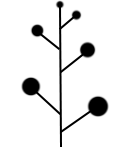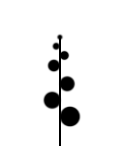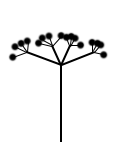Basic inflorescence structure
This exercise focuses on basic inflorescence terminology. The term inflorescence is used to describe the arrangement of flowers on a plant. There are a number of patterns of floral display, from simple axillary flowers to complex, compound displays, that are repeated throughout the plant tree of life. The stalk of an inflorescence is called the peduncle, whereas the stalks of the individual flowers in the inflorescence are called pedicels. However, when flowers are borne in a solitary fashion (i.e., not in a multi-flower inflorescence), the flower stalk is also called the peduncle.
For the following exercise, first study the images below to review the terms used to describe the basic types. For a definition of each type, mouse-over the image. Then, carefully study the unsorted images at left and drop each thumbnail into an appropriately labeled box on the right. Clicking on a thumbnail will expand the image. Click submit to check yourself. To reset, click clear or just refresh your browser.
In the illustrations below, each circle represents a flower. Larger circles represent older flowers.












© 2018–present: Dr. Alexander Krings, unless otherwise noted. Last updated Jul 2018.

